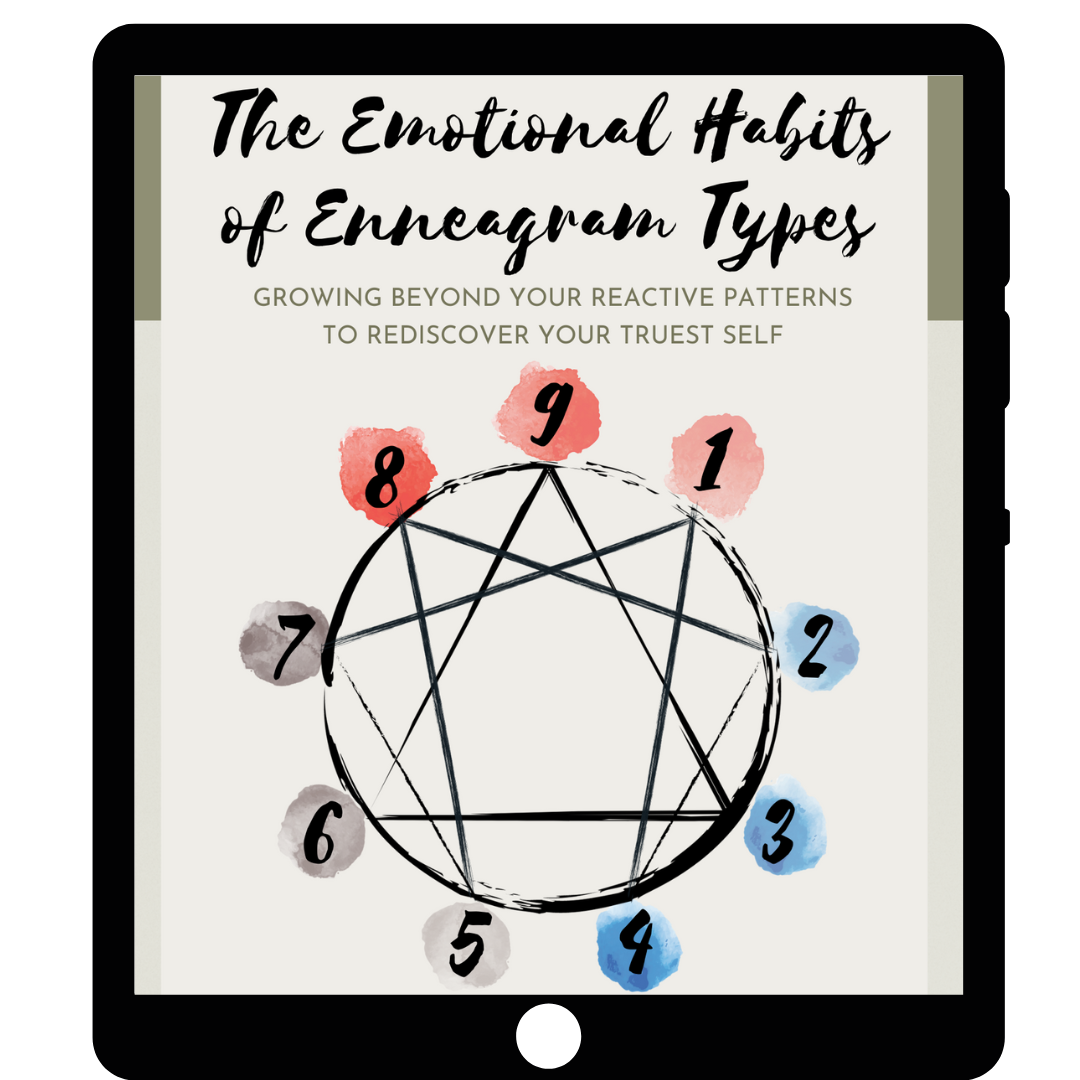The autopilot at work
Here's a juicy topic: how each Enneagram type shows up in the professional realm.
Though most people reach out to me because of their relationship with others or with themselves (*cough* the "prosocial" types on the right side of the Enneagram symbol, 9 through 4), a huge chunk of people's stressors are based on what's happening with work, job, career, vocation, etc.
Each of our Enneagram types inform our autopilot reactive patterns of thinking, feeling, and doing. These patterns USED to be helpful when we were actually powerless and vulnerable as kids, but they didn't upgrade accordingly as we grew up and gained more resources and skills.
Our professional arena is one of the main ways we see the out-of-dateness of our patterns, as we see that the very patterns that were once helpful now start creating fires and dumping gasoline on them.
For each Enneagram type, I'll describe the type's:
Motivation
Working style
Professional limits
Professional growth tips
Take a look at yours, then tell me what you think!
(Don't know what your type is? Start here!)
Type 1: The Improver
Motivation
To improve, "fix", refine, or perfect oneself, others, or the world to close the gap between the ideal and the actual.
"If I am perfect without flaws, then I'm okay/worthy"
Working Style:
Focus on whether things are right or wrong, good or bad.
Seek the highest standards of quality
Have integrity, high work ethic, and commitment
Professional Limits:
Stuck in the weeds because overly focused on details
Perfectionism, which leads to procrastination (difficulty getting started because you want to make sure the process is perfect before even beginning)
Critical of self and/or others
Overly rigid - has difficulty adjusting to changes
Frustration towards others for not having integrity or strong work ethics
Resentment when others are taking it easy, making up for their lack
Difficulty "clocking out" emotionally to rest, relax, and enjoy time outside of work
Professional Growth Tips:
Your ideal standards are a moving target - What is perfect anyway? Are your expectations and standards realistic? Appropriate? Necessary? Done is better than good.
Recognize that some of your anger is a byproduct of you underly resting and relaxing. Rest & relaxation is a deliberate spiritual/emotional discipline (that it's hard is no problem - do your best anyway)
Aim for a work quality of 80%, not 140%. (Your 80% will probably still be higher than others' 100%.)
Focus on how things are better than before, less on how you could be better going forward.
Type 2: The Befriender
Motivation
To feel liked and loved. Heavy emphasis on relationships and on using connections with others to get your own personal needs met.
"If I am easily lovable, then I'm okay/worthy"
Working Style:
Relationships are central - "It's not what you know, but who you know."
Emotional sensitivity and empathy. Sensing how others are doing and adding the human touch to projects and communication.
Use charm and warmth to make positive connections with others, using friendly or softer language
Strategically aligning with or helping others to making oneself indispensable.
Professional Limits:
Difficulty asking for help - not knowing what one needs, being scared of being rejected or judged
Difficulty receiving feedback - take it personally, get offended, spin in shame
Difficulty being direct - softening one's language so as to not upset others
Being the second in command, but rarely (if ever) the actual leader. Challenge of stepping forth as an individual, instead of as someone in relation to someone else.
Professional Growth Tips:
Take out any words/phrases that soften and dilute the main message in emails.
Ask for help and feedback. Don't take others' responses personally (their NO is more about THEM, not YOU). Take in their messages neutrally. Sometimes you'll get a yes, sometimes no.
Take a solo personal retreat. (Recommended by a fellow Enneagram 2 + business owner Melinda Olsen!)
Write down your what your ideal day would like, with lots of details from the time you wake up to the time you to go sleep.
If you’re not sure what you would like, start writing down what you DON’T want.
How can you practically make this coming week 5% closer to your ideal day than last week was? What do you need to introduce? Eliminate?
What time of day do you feel the most energized? Inspired? Set aside that time of the day for you. Protect that time for yourself as fiercely as you would protect your time with a loved one — no meetings, no one else’s agenda/needs, etc.
Type 3: The Performer
Motivation
To gain high social status by performing, achieving, and being (seen as) successful.
"If I am seen as successful, then I'm okay/worthy"
Working Style:
Goals & tasks-oriented - focus on being productive, effective, efficient.
Avoid anything that slows them down - feelings, other people, physical illness, or anything that doesn't fit their goals
Reading the audience to intuit what would be seen as valuable
Competing to win/be the best
Shapeshifting and image-managing, impressing others with competence and attractiveness.
Professional Limits:
Can be aggressive and run over other people, pushing them too hard
Overly seeking the spotlight and taking the credit
Overworking, not stopping work until life stops them
Cutting corners or reducing quality or integrity as long as you look good
Not learning from mistakes or errors because you avoid the pain of failure
Professional Growth Tips:
Slow down and rest, because you're far more than what you do or how you're seen.
Acknowledge that failure doesn't make you bad - it's human. Failure helps you grow beyond your limited perspective in life.
Spend more time to yourself so that you see who you really are and what matters most to you. Who are you when you're not in the spotlight?
What if emotions aren't things that slow you down, but make you more whole?
Type 4: The Individualist
Motivation
To sense and seek what's missing, to see how things aren't what you could have been.
"If I stand out as an individual, then I'm okay/worthy"
Working Style:
Focus on whether things are deep, authentic, or meaningful.
Point out what's inauthentic, not going well, or could have been better
Being (only) motivated by what's personally meaningful
Putting a special personal touch on projects
Professional Limits:
Working based on one's mood (which is often negative)
Stuck in the weeds because overly focused on meaning and significance
Self-doubt, self-sabotage, and resignation - not seeking what's good out of the assumption that it's not going to work out anyway (What's the point?)
Judging others for being fake, shallow, or inauthentic
Mistrusting, minimizing, or deflecting others' positive feedback/support (while wondering why you feel like you're not enough)
Indirectly pushing back against authority or not wanting to be told what to do
Professional Growth Tips:
Your blindspot includes what's GOOD about you. Your sense of self isn't accurate (though you feel it's authentic) if you only focus on what's lacking in you. Take in positive feedback from others without deflecting - they might see sides of you that you can't see yourself.
Do things because the task needs to be done, independently of how you feel.
Notice what's present (not just what's missing).
See yourself as an important (even if not central) part of the group. Your presence and contribution matters, even if it doesn't stand out.
Type 5: The Observer
Motivation
To gather knowledge and information so that you won't need or be needed by others. To not be deprived or imposed upon by others.
"If I am self-sufficient and knowledgeable, then I'm okay/worthy"
Working Style:
Focus on data and facts than people and feelings.
See things objectively and neutrally, detached from emotions.
Work independently and be very private.
Work on what is intellectually stimulating.
Professional Limits:
Take too much time in making decisions, rationalizing the need to do more "research"
Get backlogged and building stress by putting off decisions
Downplaying emotions as a source of valuable information because it's hard to "master"
Difficulty in building trusting and effective working relationships with others
Shutting down and withdrawing when overwhelmed, reinforcing the vicious stress cycle and creating further problems.
Professional Growth Tips:
See how your own stress is caused or amplified by not being in touch with your feelings and not sharing how you’re doing with others so that they might help you.
Consider what information emotions might convey (i.e., they tell us what we need). Learn to reconnect your own emotions and those of others so that you have ample resources and support - you don't have to be self-sufficient.
Without rationalizing, give yourself half as much time as you normally would take researching about a topic before making a decision.
Spend 5% more time interacting with others, sharing 5% more personal information than before for the sake of building better working relationships.
Type 6: The Contrarian
Motivation
To seek safety and security by aligning with others, following the rules, pointing out threats, or facing fears head-on.
"If I am safe, secure, and certain, then I'm okay/worthy"
Working Style:
Scan for signs of danger, risk, or untrustworthiness
Anticipate and preemptively solve potential risks - great at troubleshooting when things do go wrong
Play devil's advocate and present the opposite statement
Ask lots of questions and draw attention towards potential problem areas
Professional Limits:
Stuck in the weeds because overly focused on what could go wrong
Spend so much time and mental energy thinking, not doing - analysis paralysis, perfectionism, procrastination
Question your own strengths and achievements, leading you to miss out on great opportunities you actually are capable of - imposter syndrome
Create stress or tension within yourself or your coworkers because of your difficulty acknowledging when things are going well
Professional Growth Tips:
Verbalize to teammates that your intention is to strengthen the project by identifying potential problems upfront, not to shoot it down or criticize it. You are on the same team.
Notice when your negative read on each situation is actually you projecting your own fear outwards. Ask for feedback to get a reality check.
Gather information of all of your strengths or good decisions as much as you focus on your limitations or weaknesses. Round out your perspective of yourself and your leadership ability.
Learn to own and lead from your power and authority, not just looking to others (and then questioning them).
Type 7: The Enthusiast
Motivation
To avoid being trapped in pain by seeking pleasure and wanting options/freedom.
"If I have fun + freedom, then I'm okay/worthy."
Working Style:
Enthusiastic, fun, energetic - great at keeping spirits up
Focus on how things are going well, what good is ahead; avoid looking at the negatives or problems or just reframe them into positives.
Great creative brainstormers, idealistic idea generators, and synthesizers of seemingly unrelated information.
Great at starting; difficulty in finishing what they started. Strengths in vision casting; limitations in picking one option and following through til the end.
Professional Limits:
Avoid doing things that are boring or lacking intellectual stimulation.
Rationalize downplaying or avoiding responsibilities.
Collapse power hierarchies with those above and underneath you - "I won't tell you what to do, so don't tell me what to do." (Indirect rebellion)
Ignore problems or rationalize why things are fine when they're not.
Leaving a bunch of unfinished projects for others to deal with (and feel frustrated, confused, or resentful about).
Professional Growth Tips:
Limits are not the opposite of freedom. Imposing self-limits (i.e., self-discipline) can help you avoid unnecessary issues that get created from being non-committal and helps to actually bring about deeper, lasting rewards.
Recognize your unintentional negative impact on others; when you're too positive, you're pulling others into be extra negative. They're not imposing their limits on you; you've painted yourself into a corner because you've neglected your post. Don't make them the bad guy.
Reduce the polarization between you and others and increase balance and harmony within your team by also seeing the negative data so that others don't have to do it on your behalf (they might see more positives themselves). Meet each other in the middle.
Give more room to the grownup part of you; there will be plenty of chances for your inner child to play if important things are taken care of too. Not either/or, but both/and.
Type 8: The Challenger
Motivation
To avoid being in a vulnerable or unsafe position by stepping forth with big presence, power, and strength.
"If I am without vulnerability, then I'm okay/worthy"
Working Style:
Focus on the big picture and massive action/impact.
Seek forward movement, and will move obstacles out of the way to make things happen.
Focus on whether power is being wielded well; if not, you will challenge authority and step into the power vacuum.
Professional Limits:
Take action first, rarely aim before or reflect after. Rather than acknowledging poor decision making, justifies your own decisions or blames others for negative outcomes.
Lack of patience and aggression in your approach and communication style, steamrolling over other people if they get in the way.
Overly assumes that your perspective is right (and everyone else is wrong). Deny any other perspectives that doesn't fit yours.
Create unnecessary tension, conflict, and ruptures in your working relationships that get others to question your authority, turn on you, or leave you to your delusion that you're the best leader (when you're not).
Professional Growth Tips:
Check your own denial and delusion that your perspective is automatically the best/right perspective. Invite feedback from others without reactivity or pushback, and find a decision that's more integrating of the various perspectives. Slow down for better long-term efficacy. Ready, aim, THEN fire.
Recognize when you judge others as being weak (and therefore bad) just because they're not like you. Vulnerability is a strength of its own right. Learn to exercise your own vulnerability muscle so that you'll be a much better leader that others would happily and readily follow.
Change your body language to be more containing of your energy because you might be unintentionally intimidating for others. Rather than leading with an open chest, direct eye contact, and a louder voice, curl your shoulders inward, soften your voice, and look down and away. See what happens in the end professional outcome of you practicing softness.
Type 9: The Harmonizer
Motivation
To seek harmony and comfort by blending in, merging, not considering yourself or living as an individual.
"If I can go with the flow, then I'm okay/worthy"
Working Style:
Focus on how to dissipate tension or conflict by smoothing things out, highlighting common ground, and exercising diplomacy.
Easy-going, easy to work with, likable
Focusing on the collective well-being, harmonizing with others to further the collective's vision.
Have integrity, high work ethic, and commitment
Professional Limits:
Forgetting and even sacrificing your own well-being to avoid stirring the pot; people-pleasing and placating to the point of burnout
Procrastinate because of the difficulty in prioritizing, choosing one thing among many.
Getting carried away in the moment, zoning out or merging with the person or project in front of you.
Underly advocate on behalf of yourself or state your ideas so as to not rock the boat or stand out.
Passivity or passive aggression that leaks out through indirect means (lack of responsiveness, procrastination, distractions)
Professional Growth Tips:
Practice seeing yourself as an individual with your own valuable identity, vision, values, and strengths, and less as a cog in a machine. Allow yourself to be highlighted as an individual (seeking/receiving promotions, receiving awards, etc.).
Take more time to yourself to identify your priorities, agendas, and decisions (and write them down), then practice stating them first before hearing other people.
Recalibrate seeing conflict as a good and merging as a not great. Anger helps us focus and take effective action; placating only reinforces the time-bomb.
Next Steps
If you're wanting some more in-depth tips, I would highly recommend the book "The 9 Types of Leadership" by my Enneagram teacher Beatrice Chestnut.
Beatrice talks about how there’s no one right way of being an effective leader. All of us have a great capacity for meaningful impact, but only if we also recognize our blindspots and pitfalls that get us into trouble.
This book also covers how each of the 27 subtypes show up in professional or organizational contexts.
Work with an pro who can help you grow beyond your type!
Reach out for 1:1 support today! (I currently have a waitlist, but will make announcements of new openings when they arise.)
What are your Enneagram type's emotional habits?
Grab this free guide that shows you how to grow beyond the patterns that keep you stuck!
Don't know your Enneagram type? Find yours here!
© Copyright 2023 Joanne B. Kim. All rights reserved.
JOANNE B. KIM, LMFT
Joanne is a Licensed Marriage & Family Therapist and Certified Brainspotting Practitioner in San Jose, CA. She helps people EXHAUSTED by anxiety, shame, and an allergic reaction to anger create VIBRANT relationships where they matter, too.
Many of her clients are:
(1) the highly responsible, conscientious, and empathic types
(2) Enneagram Type Ones, Twos, Fours, or Nines
(3) Highly Sensitive Persons (HSPs)
The most common words spoken by those who’ve sat with Joanne:
“I thought it was just me. I’m NOT crazy!”
“I can finally figure out what to do with all these feelings!”














































I was a panelist at the EnneaSummit 2024 for the Enneagram Practitioner Panel.
In this panel, we share our experiences and observations about what different Enneagram types think they need in therapy, what they actually need, and some important growth steps so they can grow beyond their type.